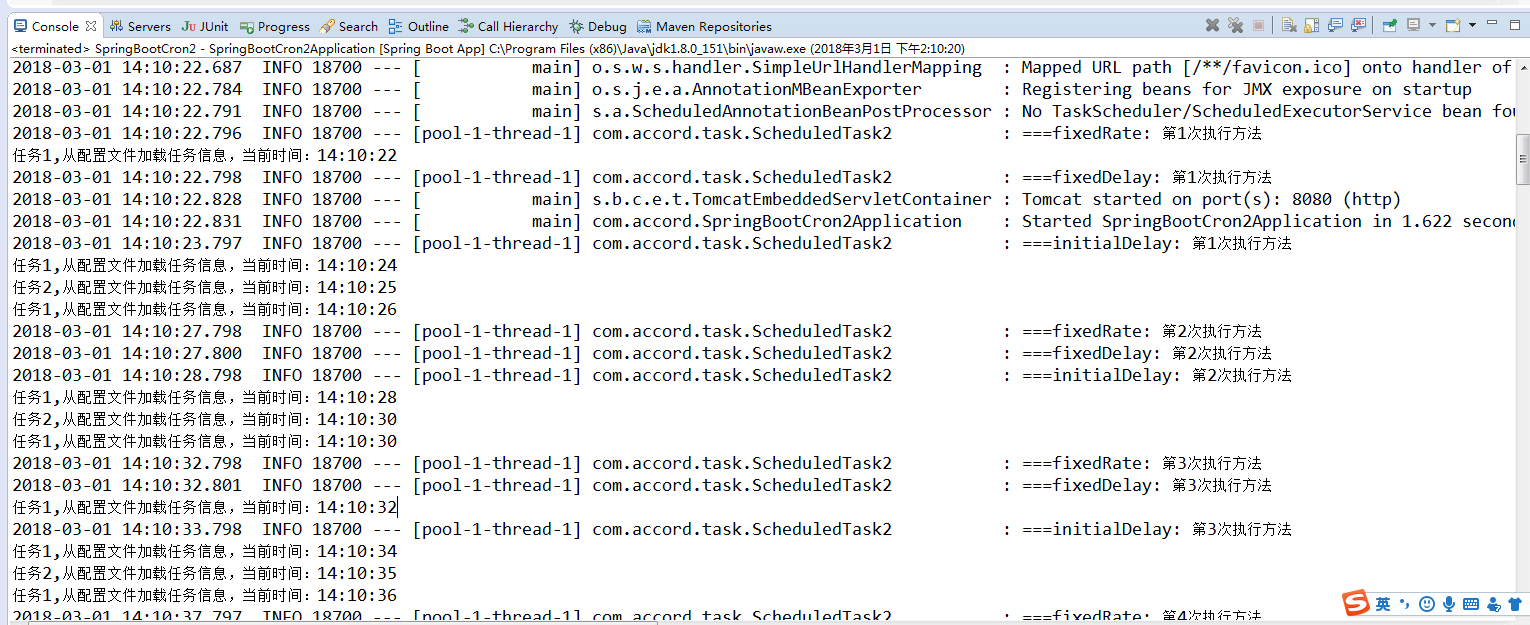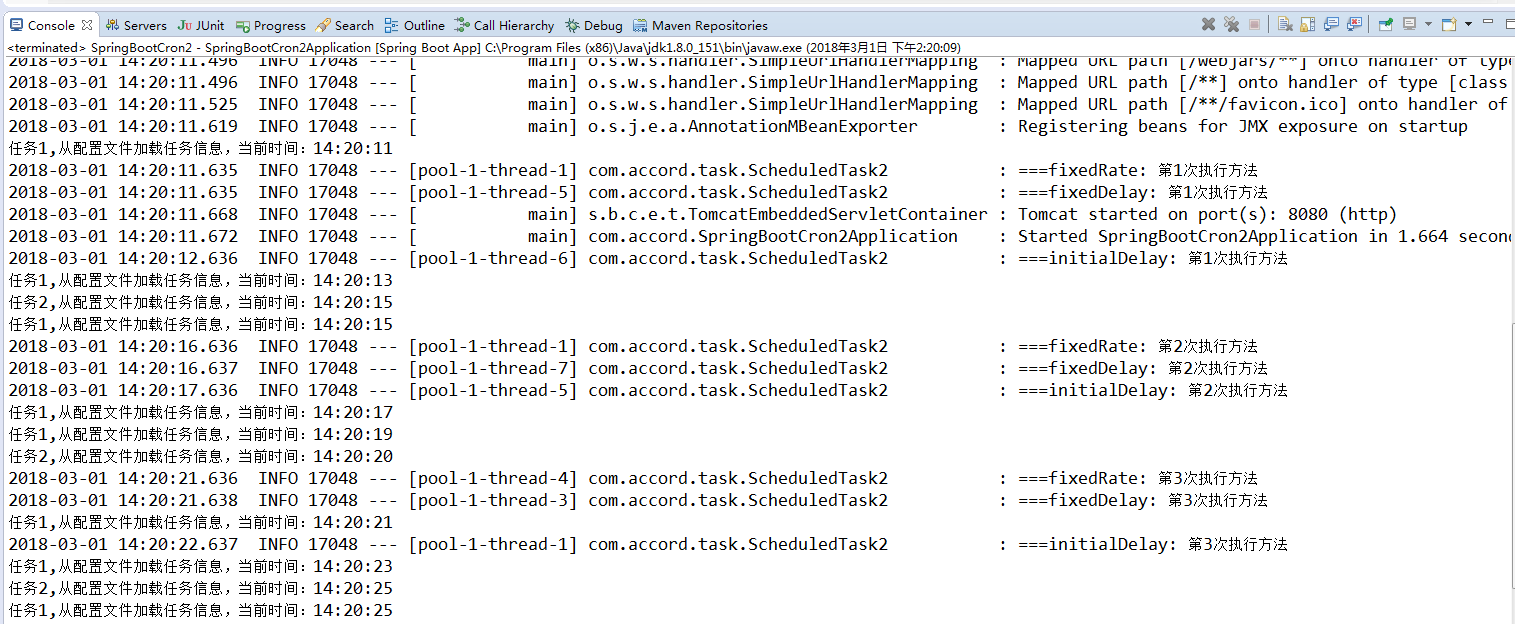Spring Boot 的定時任務: 第一種:把參數配置到.properties文件中: 代碼: package com.accord.task; import java.text.SimpleDateFormat; import java.util.Date; import org.springf ...
Spring Boot 的定時任務:
第一種:把參數配置到.properties文件中:
代碼:
package com.accord.task;
import java.text.SimpleDateFormat;
import java.util.Date;
import org.springframework.scheduling.annotation.Scheduled;
import org.springframework.stereotype.Component;
/**
* 從配置文件載入任務信息
* @author 王久印
*/
@Component
public class ScheduledTask {
private static final SimpleDateFormat dateFormat = new SimpleDateFormat("HH:mm:ss");
//@Scheduled(fixedDelayString = "${jobs.fixedDelay}")
@Scheduled(fixedDelayString = "2000")
public void getTask1() {
System.out.println("任務1,從配置文件載入任務信息,當前時間:" + dateFormat.format(new Date()));
}
@Scheduled(cron = "${jobs.cron}")
public void getTask2() {
System.out.println("任務2,從配置文件載入任務信息,當前時間:" + dateFormat.format(new Date()));
}
}
application.properties文件:
jobs.fixedDelay=5000
jobs.cron=0/5 * * * * ?
SpringBootCron2Application.java中:
package com.accord;
import org.springframework.boot.SpringApplication;
import org.springframework.boot.autoconfigure.SpringBootApplication;
import org.springframework.scheduling.annotation.EnableScheduling;
@SpringBootApplication
@EnableScheduling
public class SpringBootCron2Application {
public static void main(String[] args) {
SpringApplication.run(SpringBootCron2Application.class, args);
}
}
Spring Boot 基礎就不介紹了,推薦看這個免費教程:
註:@EnableScheduling 這個一定要加上;否則,不會定時啟動任務!
@Scheduled中的參數說明:
@Scheduled(fixedRate=2000):上一次開始執行時間點後2秒再次執行;@Scheduled(fixedDelay=2000):上一次執行完畢時間點後2秒再次執行;@Scheduled(initialDelay=1000, fixedDelay=2000):第一次延遲1秒執行,然後在上一次執行完畢時間點後2秒再次執行;@Scheduled(cron="* * * * * ?"):按cron規則執行。
第二種定時任務:單線程和多線程
1、創建定時任務:
package com.accord.task;
import org.slf4j.Logger;
import org.slf4j.LoggerFactory;
import org.springframework.scheduling.annotation.Scheduled;
import org.springframework.stereotype.Component;
/**
* 構建執行定時任務
* @author 王久印
* TODO
*/
@Component
public class ScheduledTask2 {
private Logger logger = LoggerFactory.getLogger(ScheduledTask2.class);
private int fixedDelayCount = 1;
private int fixedRateCount = 1;
private int initialDelayCount = 1;
private int cronCount = 1;
@Scheduled(fixedDelay = 5000) //fixedDelay = 5000表示當前方法執行完畢5000ms後,Spring scheduling會再次調用該方法
public void testFixDelay() {
logger.info("===fixedDelay: 第{}次執行方法", fixedDelayCount++);
}
@Scheduled(fixedRate = 5000) //fixedRate = 5000表示當前方法開始執行5000ms後,Spring scheduling會再次調用該方法
public void testFixedRate() {
logger.info("===fixedRate: 第{}次執行方法", fixedRateCount++);
}
@Scheduled(initialDelay = 1000, fixedRate = 5000) //initialDelay = 1000表示延遲1000ms執行第一次任務
public void testInitialDelay() {
logger.info("===initialDelay: 第{}次執行方法", initialDelayCount++);
}
@Scheduled(cron = "0 0/1 * * * ?") //cron接受cron表達式,根據cron表達式確定定時規則
public void testCron() {
logger.info("===initialDelay: 第{}次執行方法", cronCount++);
}
}
使用 @Scheduled來創建定時任務 這個註解用來標註一個定時任務方法。
通過看 @Scheduled源碼可以看出它支持多種參數:
- cron:cron表達式,指定任務在特定時間執行;
- fixedDelay:表示上一次任務執行完成後多久再次執行,參數類型為long,單位ms;
- fixedDelayString:與fixedDelay含義一樣,只是參數類型變為String;
- fixedRate:表示按一定的頻率執行任務,參數類型為long,單位ms;
- fixedRateString: 與fixedRate的含義一樣,只是將參數類型變為String;
- initialDelay:表示延遲多久再第一次執行任務,參數類型為long,單位ms;
- initialDelayString:與initialDelay的含義一樣,只是將參數類型變為String;
- zone:時區,預設為當前時區,一般沒有用到。
2、開啟定時任務:
package com.accord;
import org.springframework.boot.SpringApplication;
import org.springframework.boot.autoconfigure.SpringBootApplication;
import org.springframework.scheduling.annotation.EnableScheduling;
@SpringBootApplication
@EnableScheduling
public class SpringBootCron2Application {
public static void main(String[] args) {
SpringApplication.run(SpringBootCron2Application.class, args);
}
}
註:這裡的 @EnableScheduling 註解,它的作用是發現註解 @Scheduled的任務並由後臺執行。沒有它的話將無法執行定時任務。
引用官方文檔原文:
@EnableScheduling ensures that a background task executor is created. Without it, nothing gets scheduled.
3、執行結果(單線程)
就完成了一個簡單的定時任務模型,下麵執行springBoot觀察執行結果:

從控制台輸入的結果中我們可以看出所有的定時任務都是在同一個線程池用同一個線程來處理的,那麼我們如何來併發的處理各定時任務呢,請繼續向下看。
4、多線程處理定時任務:
看到控制台輸出的結果,所有的定時任務都是通過一個線程來處理的,我估計是在定時任務的配置中設定了一個SingleThreadScheduledExecutor,於是我看了源碼,從ScheduledAnnotationBeanPostProcessor類開始一路找下去。果然,在ScheduledTaskRegistrar(定時任務註冊類)中的ScheduleTasks中又這樣一段判斷:
if (this.taskScheduler == null) {
this.localExecutor = Executors.newSingleThreadScheduledExecutor();
this.taskScheduler = new ConcurrentTaskScheduler(this.localExecutor);
}
這就說明如果taskScheduler為空,那麼就給定時任務做了一個單線程的線程池,正好在這個類中還有一個設置taskScheduler的方法:
public void setScheduler(Object scheduler) {
Assert.notNull(scheduler, "Scheduler object must not be null");
if (scheduler instanceof TaskScheduler) {
this.taskScheduler = (TaskScheduler) scheduler;
}
else if (scheduler instanceof ScheduledExecutorService) {
this.taskScheduler = new ConcurrentTaskScheduler(((ScheduledExecutorService) scheduler));
}
else {
throw new IllegalArgumentException("Unsupported scheduler type: " + scheduler.getClass());
}
}
這樣問題就很簡單了,我們只需用調用這個方法顯式的設置一個ScheduledExecutorService就可以達到併發的效果了。我們要做的僅僅是實現SchedulingConfigurer介面,重寫configureTasks方法就OK了;
package com.accord.task;
import org.springframework.context.annotation.Configuration;
import org.springframework.scheduling.annotation.SchedulingConfigurer;
import org.springframework.scheduling.config.ScheduledTaskRegistrar;
import java.util.concurrent.Executors;
/**
* 多線程執行定時任務
* @author 王久印
*/
@Configuration
//所有的定時任務都放在一個線程池中,定時任務啟動時使用不同都線程。
public class ScheduleConfig implements SchedulingConfigurer {
@Override
public void configureTasks(ScheduledTaskRegistrar taskRegistrar) {
//設定一個長度10的定時任務線程池
taskRegistrar.setScheduler(Executors.newScheduledThreadPool(10));
}
}
5、執行結果(併發)

通過控制台輸出的結果看出每個定時任務都是在通過不同的線程來處理了。
來源:wangjiuyin.blog.csdn.net/article/details/79411952
近期熱文推薦:
1.1,000+ 道 Java面試題及答案整理(2022最新版)
4.別再寫滿屏的爆爆爆炸類了,試試裝飾器模式,這才是優雅的方式!!
覺得不錯,別忘了隨手點贊+轉發哦!


